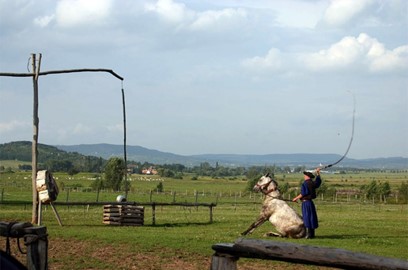year :: 1999
Belfries of Belgium and France
The Belfries of Belgium and France, a UNESCO World Heritage site recognized in 1999 and expanded in 2005, are 56 medieval civic towers across Belgium and northern France, built between the 11th and 17th centuries. Symbolizing urban autonomy and power, these belfries, often part of town halls or cloth halls, feature intricate Gothic and Renaissance designs with bells for signaling time and events. This transnational site reflects the region’s rich civic heritage, showcasing architectural innovation and the r... Read More
Cueva de las Manos
Cueva de las Manos, a UNESCO World Heritage site in Argentina, recognized in 1999, is a prehistoric rock art site in Patagonia featuring cave paintings from 13,000 to 9,500 years ago. Its vivid hand stencils, hunting scenes, and animal depictions, etched in vibrant colors along a canyon wall, reflect the artistry of early hunter-gatherers. This site showcases Argentina’s ancient heritage, preserving a stunning record of human creativity in a remote landscape.
Península Valdés
Península Valdés, a UNESCO World Heritage site in Argentina, recognized in 1999, is a coastal reserve along the Atlantic renowned for its exceptional marine biodiversity. Home to breeding grounds for southern right whales, sea lions, and Magellanic penguins, its rugged shores and steppe landscape reflect a critical wildlife haven. This site showcases Argentina’s natural heritage, offering a vital sanctuary for marine species in a pristine Patagonian setting.
Graz
The City of Graz Historic Centre and Schloss Eggenberg, a UNESCO World Heritage site in Austria, is a captivating blend of architectural heritage and cultural history. The well-preserved historic centre features a mix of medieval, Renaissance, and Baroque buildings, with cobblestone streets and a towering clocktower overlooking the city. Nearby, Schloss Eggenberg, a 17th-century palace, showcases ornate interiors and landscaped gardens tied to astronomical symbolism. This harmonious site reflects centuries ... Read More
Diamantina
Diamantina, a UNESCO World Heritage site in Brazil, is a colonial town famed for its diamond mining past and 18th-century architecture. Its cobblestone streets, Baroque churches, and vibrant houses showcase the wealth of the diamond era. Inscribed by UNESCO in 1999, it offers a well-preserved glimpse into Brazil’s colonial history. The town stands as a charming testament to the country’s cultural heritage.
Discovery Coast Atlantic Forest
The Discovery Coast Atlantic Forest Reserves, a UNESCO World Heritage site in Brazil, are a vital ecological haven preserving one of the world’s most biodiverse rainforests. Spanning coastal forests and mangroves, they shelter rare species like jaguars and golden lion tamarins amid lush, pristine landscapes. Recognized by UNESCO in 1999, they highlight Brazil’s commitment to conservation. These reserves remain a stunning showcase of the country’s natural heritage.
Atlantic Forest South East
The Atlantic Forest South-East, a UNESCO World Heritage site in Brazil, is a biodiverse rainforest region celebrated for its ecological richness. Encompassing mountains, valleys, and coastal areas, it harbors endangered species like the muriqui monkey and a vast array of plant life. Inscribed by UNESCO in 1999, it represents a critical remnant of Brazil’s Atlantic Forest. The site stands as a testament to the country’s natural legacy and conservation efforts.
Miguasha
Miguasha National Park, a UNESCO World Heritage site in Canada, is a fossil treasure trove from the Devonian period, known as the 'Age of Fishes.' Its cliffs preserve an exceptional record of 370-million-year-old marine life, including key species like the lobe-finned fish that mark the transition to land vertebrates. Recognized for its paleontological significance, it stands as a vital window into Earth’s evolutionary past.
Dazu Rock Carvings
The Dazu Rock Carvings, a UNESCO World Heritage site in China, are a remarkable collection of ancient stone sculptures etched into cliffs, blending Buddhist, Taoist, and Confucian themes. Created between the 9th and 13th centuries, these intricate reliefs depict deities, historical figures, and daily life with exceptional artistry. Preserved in their natural setting, they offer a profound glimpse into China’s spiritual and cultural evolution.
Mount Wuyi
Mount Wuyi, a UNESCO World Heritage site in China, is a stunning landscape of jagged peaks, winding rivers, and lush forests, revered for its natural and cultural significance. Home to ancient tea plantations, cliffside temples, and rare wildlife, it reflects a harmonious blend of Taoist heritage and biodiversity. This scenic marvel has inspired Chinese art and philosophy for centuries.
Guanacaste
Guanacaste, a UNESCO World Heritage site in Costa Rica, is renowned for its rich biodiversity and well-preserved tropical dry forests. This protected region showcases a variety of ecosystems, including wetlands, grasslands, and oak forests, supporting numerous species of plants and animals, some of which are endemic. Its cultural significance is tied to traditional cattle ranching practices and historical haciendas, reflecting the area's deep-rooted heritage. The site's conservation efforts highlight its im... Read More
Viñales Valley
Viñales Valley, a UNESCO World Heritage site in Cuba, is renowned for its stunning natural beauty and cultural significance. This lush, fertile region features dramatic limestone karsts, traditional tobacco farms, and vibrant rural communities that preserve time-honored agricultural practices. Visitors can explore its unique landscape, dotted with mogotes—steep, rounded hills—and underground caves, while experiencing the authentic charm of Cuban countryside life. Its blend of geological wonders and living h... Read More
Desembarco del Granma
Desembarco del Granma National Park, a UNESCO World Heritage site in Cuba, is renowned for its unique coastal cliffs, marine terraces, and pristine ecosystems. The park commemorates the historic landing of Fidel Castro and his revolutionaries in 1956, marking a pivotal moment in Cuban history. Its dramatic limestone formations, lush forests, and diverse wildlife, including rare species, make it a significant natural and cultural landmark.
Litomysl Castle
Litomyšl Castle, a UNESCO World Heritage Site in Czechia, is a stunning example of a Renaissance arcade castle, constructed between 1568 and 1581 for the Pernštejn family. Its unique sgraffito-decorated exterior, featuring over 8,000 intricate designs, and elegant arcades reflect Italian influences adapted to Central European style. The castle also boasts an 18th-century Baroque theater and luxurious interiors, earning its place on the UNESCO list in 1999 for its architectural significance and historical pr... Read More
Santa Ana de los Ríos de Cuenca
Santa Ana de los Ríos de Cuenca, a UNESCO World Heritage site in Ecuador, is a well-preserved colonial city founded in 1557, renowned for its historical architecture and cultural significance. Its urban layout, featuring narrow cobblestone streets and whitewashed buildings with red-tiled roofs, reflects a blend of Spanish and indigenous influences. The city’s designation in 1999 highlights its role as a testament to colonial planning and its enduring heritage, making it a key cultural landmark in South Amer... Read More
Sammallahdenmaki
Sammallahdenmäki, a UNESCO World Heritage Site in Finland, is a Bronze Age burial ground dating back to 1500–500 BC. It features 33 granite cairns, showcasing the funerary practices and social structures of Scandinavian Bronze Age culture. Notable structures include the unique 'Church Floor' and the elongated 'Long Ruin of Huilu,' set within a striking natural landscape. Inscribed in 1999, it offers a glimpse into ancient rituals, possibly linked to sun worship, and remains freely accessible to visitors.
Saint Emilion
The Jurisdiction of Saint-Émilion, a UNESCO World Heritage site in France, is a historic village renowned for its medieval architecture and exceptional viticultural landscape. Its well-preserved monolithic church, carved from a single limestone rock, and ancient underground catacombs highlight its rich history dating back to Roman times. The site’s unique blend of cultural heritage and centuries-old winemaking tradition, producing some of the world’s finest red wines, earned it global recognition. Visitors ... Read More
Museumsinsel
Museumsinsel, a UNESCO World Heritage site in Germany, is a unique island complex housing five world-class museums built between the 19th and early 20th centuries. Renowned for its neoclassical architecture, it showcases an extraordinary collection of art and artifacts spanning human history. The site reflects Germany’s commitment to cultural preservation and enlightenment ideals. Each museum, from ancient treasures to European masterpieces, offers a distinct narrative of civilization. This harmonious ensem... Read More
Wartburg Castle
Wartburg Castle, a UNESCO World Heritage site in Germany, is a medieval fortress perched atop a hill, dating back to the 11th century. Known for its role in sheltering Martin Luther during the Reformation, it blends Romanesque and Gothic architecture. The castle’s grand halls and towers reflect its historical significance as a cultural and political hub. Its well-preserved state offers a glimpse into feudal life and German heritage. This iconic site symbolizes both spiritual legacy and architectural prowess... Read More
Mycenae and Tiryns
The Archaeological Sites of Mycenae and Tiryns, recognized as a UNESCO World Heritage site, showcase the impressive remnants of two major centers of the Mycenaean civilization, flourishing from the 15th to 12th century BCE. These sites feature monumental cyclopean walls, elaborate palaces, and well-preserved tombs, reflecting the architectural and cultural achievements of this ancient Greek society. Excavations have uncovered artifacts like the famous Lion Gate and gold masks, offering insights into the wea... Read More
Pátmos Island
Pátmos Island, a UNESCO World Heritage site in Greece, is renowned for its historical and cultural significance. This small Aegean island is home to the Cave of the Apocalypse, where St. John the Evangelist is said to have received the visions recorded in the Book of Revelation, and the imposing Monastery of Saint John, a well-preserved example of Byzantine architecture. Its charming villages, pristine beaches, and serene atmosphere make it a unique destination steeped in spirituality and tradition.
Hortobágy
Hortobágy, a UNESCO World Heritage site in Hungary, is a vast steppe landscape renowned for its unique cultural and natural heritage. This expansive plain showcases traditional pastoral practices, including the iconic Hungarian cattle herding by csikós (mounted herdsmen), alongside a rich biodiversity of rare bird species and grasslands. Recognized for its historical significance and ecological value, Hortobágy offers a glimpse into centuries-old traditions harmonized with nature, making it a remarkable tes... Read More
Mountain Railways of India
The Mountain Railways of India, a UNESCO World Heritage site, showcase an impressive feat of engineering with their scenic routes through rugged terrain. Constructed between the late 19th and early 20th centuries, these railways highlight innovative solutions to challenging landscapes, blending historical significance with stunning natural beauty. They remain operational, offering a unique travel experience while preserving their cultural and technical legacy.
Lorentz
Lorentz National Park, a UNESCO World Heritage site in Indonesia, is renowned for its exceptional biodiversity and stunning landscapes. This protected area encompasses a range of ecosystems, from coastal mangroves to alpine peaks, harboring rare species like the long-beaked echidna and the southern cassowary. It also holds significant cultural value, with indigenous communities maintaining traditional lifestyles amidst its vast wilderness. The park stands as a critical conservation zone, showcasing Indonesi... Read More
Villa Adriana
Villa Adriana, a UNESCO World Heritage site in Italy, is an extraordinary Roman architectural complex built in the 2nd century AD as a retreat for Emperor Hadrian. This sprawling estate blends innovative design with elements inspired by Greek, Egyptian, and Roman cultures, featuring palaces, theaters, baths, and gardens. Renowned for its sophisticated layout and engineering, including water systems and decorative structures, it exemplifies imperial luxury and the artistic vision of antiquity.
























